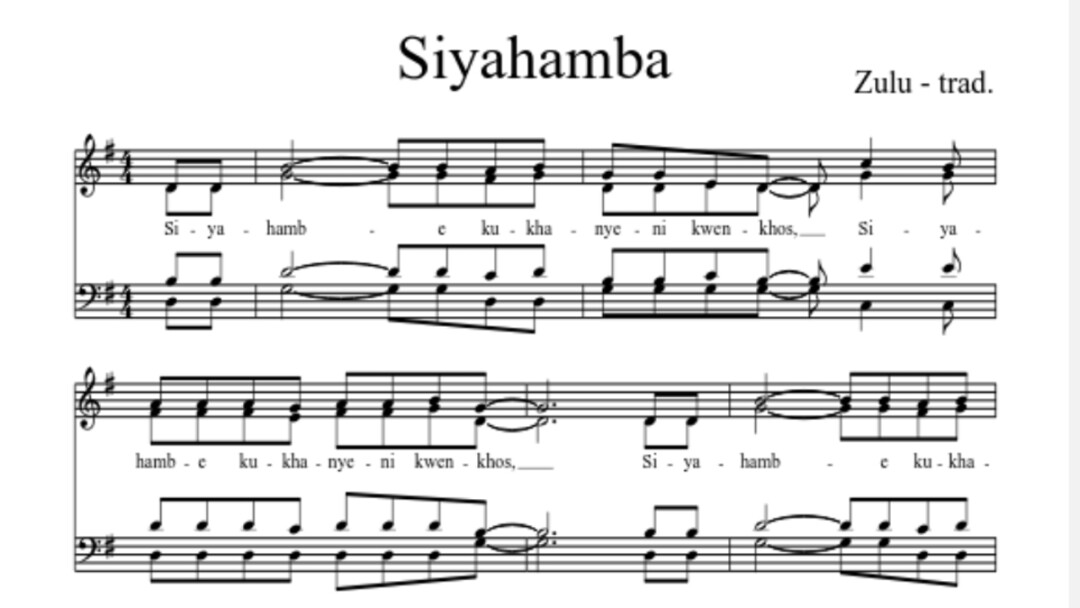
Pender UMC Carillon and Joy Ringers, directed by Brian Stevenson, combined to play Siyahamba for their final offering of the 2024 school year.
Arranged by R. Ward for handbells, this song is in The Faith We Sing, page 2235-b.
This traditional Zulu song, sometimes titled "Freedom Song", is usually sung by the men of the tribe. This arrangement was conceived with the idea of the march approaching from a distance, passing directly in front and then fading away in the distance. The addition of suitable ethnic instruments, such as gourd rattles, hand drums etc. is encouraged.
The Power and Significance of South African Freedom Songs
South African freedom songs have found a significant place in North American hymnals, with “Siyahamba” being one of the most accessible and beloved. Understanding the historical context and meaning of these songs can deepen their impact on us today.
Origins and Historical Context
Freedom songs were a vital part of the protest, struggle, and solidarity movements for black South Africans, particularly from the 1960s through the 1990s. One of the most infamous events in this struggle was the Sharpeville massacre on March 21, 1960, where police opened fire on demonstrators, killing sixty-nine people. The anti-apartheid struggle in the 1980s further brought global attention, with news reports often featuring these powerful songs of freedom.
The musical roots of these songs are a blend of traditional African music and Western hymnody, influenced by trade, commerce, and European missions dating back to the 17th century. “Siyahamba” and similar songs often originated with Amadodana, a Methodist young men’s group.
Meaning and Interpretation
“Siyahamba,” usually translated as “We are marching in the light of God,” holds layers of meaning. “We” signifies community, including both the living and the departed, who continue to influence the living. “Marching” unifies the community, symbolizing a collective, spirited journey rather than passive acceptance.
“The Light of God” symbolizes creation, Jesus Christ, and is a common refrain in healing songs throughout Southern and Central Africa. It represents clear vision and truth, essential for navigating struggles and finding hope.
When sung in worship, these songs embody and facilitate a growing, evolving community of believers. They connect the struggles of the streets with the sanctity of worship, creating a permeable boundary between the two.
Global Dissemination and Impact
Anders Nyberg, a Swedish musician, played a pivotal role in spreading South African freedom songs globally. His choir, Fjedur, interacted with South African choirs in the 1970s, and Nyberg’s transcriptions were published and performed worldwide. The collection “Freedom Is Coming: Songs of Protest and Praise from South Africa” captured the imagination of church choirs in the United States, leading to the inclusion of songs like “Siyahamba,” “Freedom Is Coming,” and “Thuma Mina” in many hymnals.
Nyberg and his wife, Jennifer Ferguson, hold dual Swedish and South African citizenship and continue to share these powerful songs. Their efforts have made South African freedom songs a universal symbol for those fighting for freedom.
Personal Experiences and Global Reach
From Haiti to Cuba, Sweden to Taiwan, South African freedom songs have transcended cultural boundaries. In Haiti, these songs served as a bridge to connect African and Haitian cultures through themes of liberation. In Cuba, they were taught in Spanish, resonating with local congregations. In Taiwan, a Presbyterian youth choir sang “Freedom Is Coming” in Mandarin, symbolizing their struggle for freedom.
In South Africa, these songs remain an important genre, even in the post-apartheid era. They are sung alongside Western hymns and traditional South African music, continuing to inspire hope and solidarity.
When we sing South African freedom songs in our worship, we not only honor the hopes of South Africans but also join in their struggle for freedom. These songs, with their rich history and profound meanings, remind us of the power of music to unite and inspire communities across the globe.


